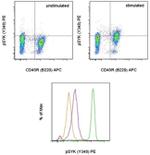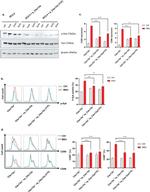Search Thermo Fisher Scientific
Invitrogen
Phospho-Syk (Tyr348) Monoclonal Antibody (moch1ct), PE, eBioscience™
FIGURE: 1 / 2
Phospho-Syk (Tyr348) Antibody (12-9014-42) in Flow


Product Details
12-9014-42
Species Reactivity
Published species
Host/Isotype
Recommended Isotype Control
Class
Type
Clone
Conjugate
Excitation/Emission Max
Form
Concentration
Purification
Storage buffer
Contains
Storage conditions
Shipping conditions
RRID
Product Specific Information
Description: This moch1ct monoclonal antibody recognizes human and mouse spleen tyrosine kinase (also known as SYK) when phosphorylated on tyrosine 348 (Y348). SYK is the founding member of the SYK family of kinases that also includes ZAP-70 (zeta-associated protein of 70 kD) and is expressed in hematopoietic cells, including B lymphocytes, immature (CD4, CD8 double-negative and double-positive) thymocytes, and myeloid cells, epithelial cell lines, and normal breast tissue. SYK is critical for B cell receptor (BCR) signaling and B cell development. Autophosphorylation of at Y348 is necessary for SYK to become fully catalytically active and creates a docking site for the SH2 domains of Vav, Grb2, p85 subunit of PI3 kinase, and PLC gamma.
Specificity of this moch1ct clone was confirmed by ELISA, flow cytometry, and western blotting.
Applications Reported: This moch1ct antibody has been reported for use in intracellular staining followed by flow cytometric analysis.
Applications Tested: This moch1ct antibody has been pre-titrated and tested by intracellular staining followed by flow cytometric analysis of stimulated mouse splenocytes. This can be used at 5 µL (0.06 µg) per test. A test is defined as the amount (µg) of antibody that will stain a cell sample in a final volume of 100 µL. Cell number should be determined empirically but can range from 10^5 to 10^8 cells/test.
Staining Protocol: All protocols work well for this monoclonal antibody. Use of Protocol A: Two-step protocol: intracellular (cytoplasmic) proteins allows for the greatest flexibility for detection of surface and intracellular (cytoplasmic) proteins. Use of Protocol B: One-step protocol: intracellular (nuclear) proteins is recommended for staining of transcription factors in conjunction with surface and phosphorylated intracellular (cytoplasmic) proteins. Protocol C: Two-step protocol: Fixation/Methanol allows for the greatest discrimination of phospho-specific signaling between unstimulated and stimulated samples, but with limitations on the ability to stain specific surface proteins (refer to "Clone Performance Following Fixation/Permeabilization" located in the Best Protocols Section under the Resources tab online). All Protocols can be found in the Flow Cytometry Protocols: "Staining Intracellular Antigens for Flow Cytometry Protocol" located in the Best Protocols Section under the Resources tab online.
Excitation: 488-561 nm; Emission: 578 nm; Laser: Blue Laser, Green Laser, Yellow-Green Laser.
Filtration: 0.2 µm post-manufacturing filtered.
Target Information
Spleen tyrosine kinase (SYK), along with ZAP70, are cytoplasmic tyrosine kinases that are viewed as potential druge targets for allergic disorders and autoimmune diseases. SYK may also play a role in cancer. Syk translocates to the plasma membrane upon B cell antigen receptor (BCR) or the high-affinity IgE receptor (FcepsilonRI) triggering, and phosphorylates downstream adaptor proteins, thereby providing docking sites for initiation of subsequent signaling pathways, such as calcium mobilization, cytoskeleton remodeling, or transcription of specific genes. Syk binds to the receptor assemblies through interactions of its pair of SH2 domains with ITAM motives of the receptor, which have been phosphorylated by Src-family kinases. These kinases also help to activate Syk by phosphorylation of its activation loop.
For Research Use Only. Not for use in diagnostic procedures. Not for resale without express authorization.
How to use the Panel Builder
Watch the video to learn how to use the Invitrogen Flow Cytometry Panel Builder to build your next flow cytometry panel in 5 easy steps.
Bioinformatics
Protein Aliases: DKFZp313N1010; EC 2.7.10.2; FLJ25043; FLJ37489; HGNC:11205; kinase Syk; KSYK; p72-Syk; SP1; Spleen tyrosine kinase; syk signaling; tyrosine-kinase syk; Tyrosine-protein kinase SYK
Gene Aliases: p72-Syk; ptk72; SYK; Sykb
UniProt ID: (Human) P43405, (Mouse) P48025
Entrez Gene ID: (Human) 6850, (Mouse) 20963

Performance Guarantee
If an Invitrogen™ antibody doesn't perform as described on our website or datasheet,we'll replace the product at no cost to you, or provide you with a credit for a future purchase.*
Learn more
We're here to help
Get expert recommendations for common problems or connect directly with an on staff expert for technical assistance related to applications, equipment and general product use.
Contact tech support

